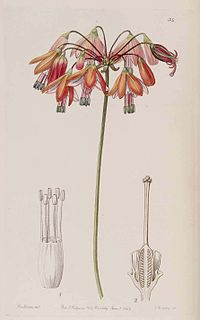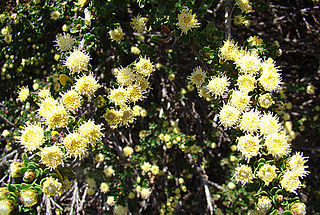
Epimedium, also known as barrenwort, bishop's hat, fairy wings, horny goat weed, or yin yang huo, is a genus of flowering plants in the family Berberidaceae. The majority of the species are endemic to China, with smaller numbers elsewhere in Asia, and a few in the Mediterranean region.

Epimedium grandiflorum, the large flowered barrenwort, or bishop's hat, is a species of flowering plant in the family Berberidaceae, native to China, Japan and Korea. It is known as dâm dương hoắc in Vietnamese.

Rosa minutifolia is a species in the genus Rosa. It is also known by the common names Baja rose, Baja littleleaf rose, and small-leaved rose.

Epimedium × rubrum, known as red barrenwort, is a species of perennial flowering plant in the family Berberidaceae, cultivated in gardens. It is considered to be a hybrid between E. alpinum and E. grandiflorum. The Royal Horticultural Society has given it the Award of Garden Merit (AGM).

Sorbus pseudovilmorinii is a variable deciduous flowering tree.

Epimedium pinnatum is a species of flowering plant in the barberry family Berberidaceae, native to northern Iran. It is a slowly-spreading evergreen perennial growing to 30 cm (12 in) tall and broad, with oval hairy leaves and bright yellow spurred flowers in late Spring and early Summer.

Bessera elegans, also known by the common name coral drops, is a cormous herbaceous perennial flowering plant in the family Asparagaceae, from Mexico.

Camellia cuspidata, also known by the common name cuspidate camellia, is a species in the genus Camellia, in the family Theaceae. It is native to China, specifically the west. It occurs in the provinces of Anhui, Fujian, Guangdong, Guangxi, Guizhou, Hubei, Hunan, Jiangxi, Shaanxi, Sichuan, Yunnan, Zhejiang.

Pachysandra axillaris is a species of plant in the family Buxaceae. In its native China, it is known as 板凳果.

Disporum megalanthum is a deciduous rhizomatous perennial plant in the family Colchicaceae.

Epimedium alpinum, the alpine barrenwort, is a species of flowering plant in the genus Epimedium, native to the mountains of Italy, Austria, the former Yugoslavia, and Albania, and introduced into central Europe. A dwarf perennial suitable for rock gardens, it was jocularly said by John Lindley to be "known only in the gardens of botanists". Its hybrid with E. grandiflorum, Epimedium × rubrum, has gained the Royal Horticultural Society's Award of Garden Merit.

Illicium henryi, also known by the common names Henry anise tree and Chinese anise tree is a species in the genus Illicium in the family Schisandraceae.

Baccharis patagonica is a species in the genus Baccharis in the family Asteraceae. It is native to southern Argentina and central and southern Chile, including the Juan Fernández Islands.

Osmanthus armatus, also known by the common name devil wood or Chinese vernacular name 红柄木犀 is a species in the genus Osmanthus in the family Oleaceae. It is native to China, specifically the west or central and southeast.

Stachyurus salicifolius, also known by the Chinese vernacular name 柳叶旌节花, is a species in the genus Stachyurus in the family Stachyuraceae. It is native to China, specifically Chongqing, Sichuan, and northeast Yunnan.

Clematis urophylla is a species in the genus Clematis in the family Ranunculaceae. It is native to China, specifically the southwest or south central and southeast. It can be found wild in the provinces of Guangdong, Guangxi, Guizhou, Hubei, Hunan, and Sichuan.

Haplopappus glutinosus, known also by the common name sticky haplopappus is a species of plant in the genus Haplopappus in the family Asteraceae. It is native to Chile and Argentina.

Phillyrea angustifolia, also known by the common name narrow-leaved mock privet is a species in the genus Phillyrea in the family Oleaceae. It is native to the western and central Mediterranean, including Albania, Algeria, Balearic Islands, Corsica, France, Italy, Morocco, Portugal, Sardinia, Sicily, Spain, Tunisia, and Yugoslavia.

Polystichum makinoi is a species of fern in the genus Polystichum in the family Dryopteridaceae. It is native to Bhutan, China, India, Japan, Nepal, Tibet, North Korea, South Korea, and Myanmar.

Sycopsis is a genus of plants in the family Hamamelidaceae native to southern central China and Taiwan.




















